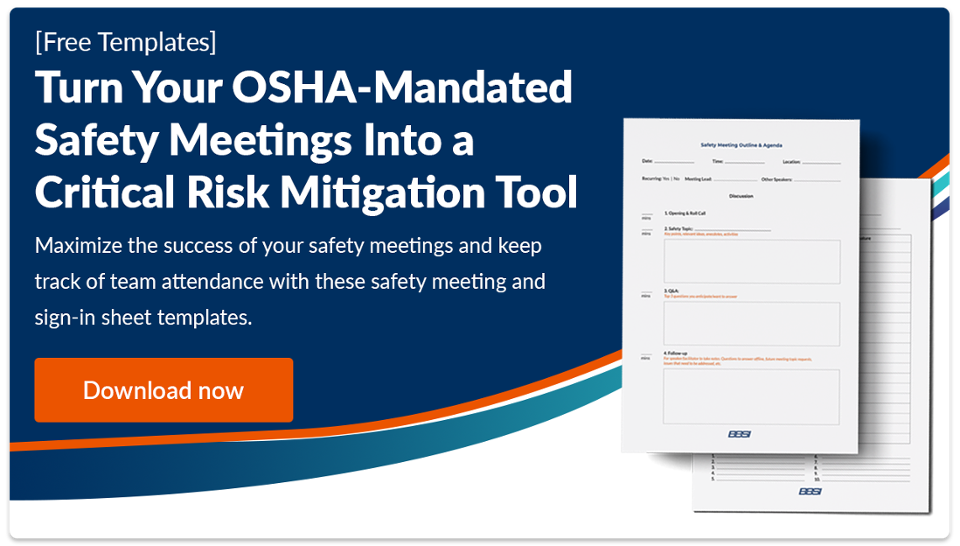
Safety Meeting Best Practices & Topics to Cover ASAP
When it comes to workplace safety, it is paramount that all employees understand the role they play in keeping themselves and their coworkers safe on the job. One of the best ways to reinforce a safe working environment is through consistent safety meetings.
This article will explain the importance of safety meetings, present you with best practices, and provide some essential safety topics for meetings to cover with your own team.
What is a Safety Meeting?
Safety meetings are sessions for you and your employees to discuss different topics and regulations related to safety within your industry. The key to any successful safety meeting is to make the topics relevant to your team’s everyday jobs.
When Should You Have a Safety Meeting?
OSHA requires any organization, big or small, to conduct safety meetings monthly or quarterly. Because humans are creatures of habit, you should make safety meetings part of your team’s routine by scheduling meetings at the same time on the same day of the month. They will soon come to expect them.
In addition to your monthly or quarterly gathering, you should conduct safety meetings when your team has a new project to prepare for, or after an incident occurs.
New projects usually come with new potential hazards, and you should make your workers aware of them. You don't have to schedule separate meetings to discuss the potential kinks of a new project as long as you include them in your regular safety meeting.
If someone gets hurt on the job, your employees will want to know what happened. Use a safety meeting as an opportunity to discuss what went wrong and how you can avoid these accidents in the future. Be honest about the incident and avoid blaming people. Let your team know that you’re focused on making this right and keeping them safe.
4 Steps for Structuring a Successful Safety Meeting
Why are Safety Meetings Important?
Connect with Boots on the Ground
Well-planned meetings that focus on topics relevant to your company not only reinforce safety rules; they give your employees the chance to ask questions and raise their concerns.
Your boots-on-the-ground employees have first-hand experience with daily hazards, and often see what's happening on-site before the supervising managers do. If the safety meeting topics don’t relate to what's happening on the ground, they will likely lose interest fast.

Maintain Financial Wellbeing
Workplace accidents come at a price, both in terms of human life and company costs. If workers start cutting corners while operating a piece of equipment, they risk their safety and jeopardize the company's bottom line.
Safety meetings will reinforce best practices for using equipment and make it clear that negligence isn’t an option.
Keep Employee Morale High with Safety Meetings
A fatal injury is like a black mark on a company's reputation and the consequences can last for months, or even years. Customers may decide to stop buying from your company, strategic partnerships may dissolve or be put on hold, and job candidates might avoid your company if they think it’s not safe. This negative information can affect public perception and hurt your business.
Even a non-fatal workplace accident will affect the injured worker and the entire company. An injured employee will likely need time off, leading to productivity losses and low morale among colleagues picking up the extra work. Overworking your employees or failing to sufficiently train temporary staff can lead to more workplace accidents and injuries, creating a vicious cycle that can impact the company's bottom line.
On the flipside, prioritizing safety and creating a strong safety culture sends a clear message to your employees that you care about their wellbeing. One study found that when organizations focus on building a strong workplace safety culture, productivity goes up by 24%. Proactive safety measures not only show employees you care; they also allow your team to focus on their work, rather than the dangers in their workplace. Safety leads to reduced hazards, reduced hazards lead to happier employees, and happier employees lead to higher productivity.
[RESOURCE PACK] Modified Duty: Get Employees Back to Work After an Injury
Practice What You Preach
It's not enough to have a list of rules and to boast about "safety first" if no one complies. Safety meetings that talk about safety practices, reinforce them, and allow your employees to raise concerns will show your team that you practice what you preach.
Who Needs to Participate in Safety Meetings?
Unless you have a small company with just a handful of employees, it’s impractical to include the entire team in your safety meetings. Realistically, you need to include everyone whose job pertains to the topic. For example, if you want to discuss how to wear harnesses correctly with your construction workers, you shouldn’t include the accounting department.
In addition to the crew, you will need an authoritative and knowledgeable figure running the meeting to keep everyone in check. Otherwise, your team may disengage and tune out the information.
Don’t Treat Safety Meetings Like a Chore
It's not unusual for employees to view safety meetings as a waste of their valuable working time. So, how do you get them to be more engaged?
Have a Knowledgeable and Engaged Presenter
When planning safety meetings, avoid randomly appointing someone to present the topic of the week. The presenter should be knowledgeable and engaged. Your audience can quickly tell if the presenter knows what they’re talking about and if they have real, applicable experience. If they feel the person facilitating the meeting isn't knowledgeable enough, they will quickly lose interest. To help your presenter gather their thoughts and prepare, have them create a quick outline with the points they want to hit on during the meeting. This will help them be more confident in their presentation and send a clear message to your team that the company takes safety meetings seriously.
Choose the Right Time of Day and Keep It Short
How many of your employees will pay attention during a safety meeting at the end of the day when they’re eager to get home? Meetings should be 20 minutes at the beginning of the day when everyone is fresh and rested. Twenty minutes should give you enough time to cover relevant topics and answer questions without losing their attention. You can also bring extra incentives to engage them, like coffee, donuts, or breakfast burritos.

Make Sure the Employees Have Buy-in
The purpose of safety meetings is to keep your employees safe. They should show your employees you care about their safety, and shouldn’t just check an OSHA box. Encouraging participation and crowdsourcing new topics is a good way to make employees feel included. After all, they are the ones most affected by the protocols.
Make the Safety Meeting Relevant to Their Job
A crucial lesson in marketing is to speak the language of your audience. Apply this to your safety meetings too.
If your audience is a group of blue-collar workers, don't just recite the OSHA manual. Instead, speak their language. Tell them, "We are going to be erecting a two-stage metal scaffold with 10-foot spans. We’ll have a minimum of three boards across there. These are the do's and don'ts."
Relating topics back to their job makes the meeting feel more like a conversation and less like a lecture.
Emphasize Protecting the Team
Help your teams understand that protocols exist to keep everyone safe and to tell them what to do in case of an emergency. If something happens, they need to know how to help an injured or in-danger teammate. In office environments, that could be as easy as running fire drills or appointing someone to conduct a headcount. On construction sites, it could be knowing how to help your coworker who fell while tying rods of rebar.
Make Safety Meetings Engaging and Conversational
As previously mentioned, lecturing your employees and reciting the OSHA manual will lose their attention almost immediately. Instead, ask questions and encourage them to participate in the conversation. Turn these meetings into teachable moments, and allow your team to offer feedback and advice.
Safety Meeting Topics to Cover ASAP
General Safety Mistakes
General safety mistakes are simple and innocent errors that employees make unintentionally. For example, they may wear their safety equipment incorrectly or use the wrong equipment without knowing.
Remember not to point fingers or blame anyone in particular. The purpose of these meetings is to educate your employees, not shame them.

Fire Safety
Depending on the type of job site, fire is an ever-present danger. Make sure to discuss fire protection, fire prevention, and evacuation plans.
Fire Prevention: Clearly communicate tactics and protocols to prevent fires.
Fire Protection: In case of fire, the worksite should have access to water, fire hoses, and/or extinguishers.
Evacuation Plans: Make sure your teams know what to do and where to go in case of a fire.
Workplace Accidents: Reporting, Prevention, and Costs
Reporting: Help employees understand the importance of reporting accidents. It's not for pointing fingers and naming names, but rather for understanding why, how, and where these incidents occur, and what you can do to prevent them.
Prevention: Your organization should know what accidents are common in your line of work. Educate your employees about the best ways to prevent them.
Job Hazard Analysis (JHA)
Job hazard analysis (JHA) helps your employees identify job risks before they happen. This protocol will enable your team to minimize or eliminate the risk associated with work activity.
Personal Protective Equipment (PPE)
The PPE required for your employees depends on your industry. During the COVID-19 pandemic, PPE became synonymous with masks, face shields, surgical gowns, and more. However, PPE is any kind of equipment that keeps someone safe while doing their job.
If you introduce new equipment to your employees, you must show them how to properly use it. For example, if they have new harnesses, ask your workers to bring them to the safety meeting. Then, demonstrate the correct way to wear them and how to ensure a proper fit.
Hazard Communication
Hazard communication teaches your workers what they need to know when handling chemicals. Your HazCom should include educating your employees about the hazardous materials, proper material handling, necessary PPE, how to dispose of and store the material, and emergency protocols.
How A BBSI Consultant Can Assist With Safety Meetings
Safety meetings are not a one-and-done kind of event. Safety meeting topics should evolve to stay relevant to what's happening in your company.
If you’re not sure where to start, BBSI can help. A BBSI Risk Consultant will audit your current safety meetings procedure, identify the issues, and help you improve their structure. They can also identify the safety meeting topics most relevant to your team and provide leadership training to help ensure your workers truly benefit from the meetings.
Contact your local branch today to learn more about how BBSI can help you keep your team safe.
Disclaimer: The contents of this white-paper/blog have been prepared for educational and information purposes only. Reference to any specific product, service, or company does not constitute or imply its endorsement, recommendation, or favoring by BBSI. This white-paper/blog may include links to external websites which are owned and operated by third parties with no affiliation to BBSI. BBSI does not endorse the content or operators of any linked websites, and does not guarantee the accuracy of information on external websites, nor is it responsible for reliance on such information. The content of this white-paper/blog does not provide legal advice or legal opinions on any specific matters. Transmission of this information is not intended to create, and receipt does not constitute, a lawyer-client relationship between BBSI, the author(s), or the publishers and you. You should not act or refrain from acting on any legal matter based on the content without seeking professional counsel.
